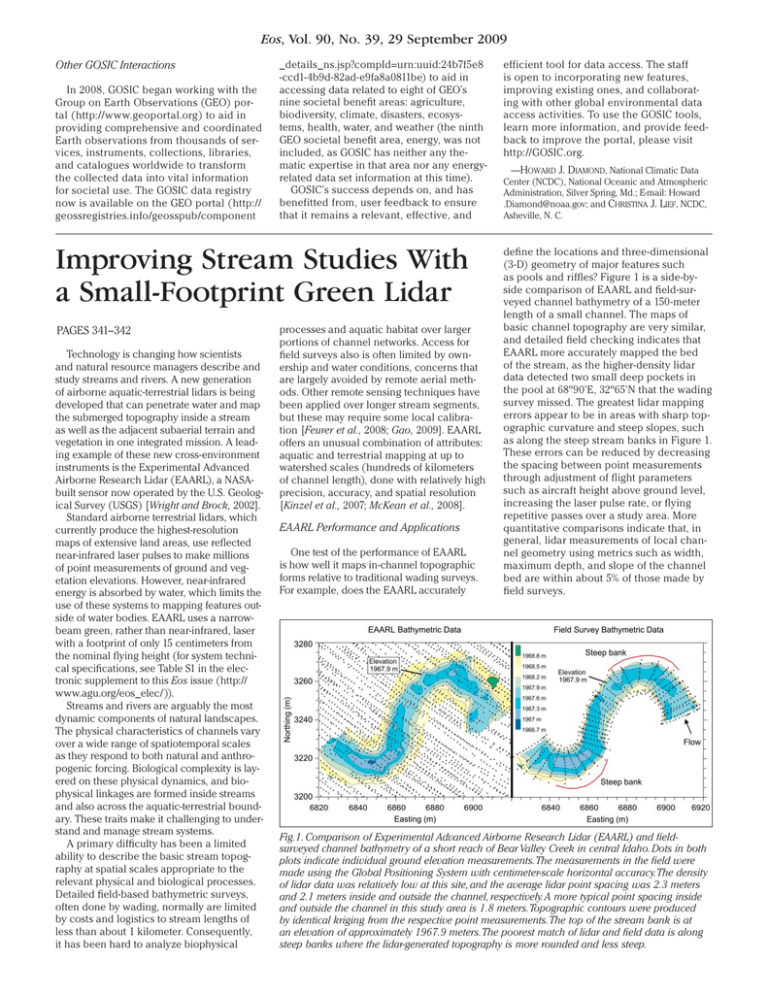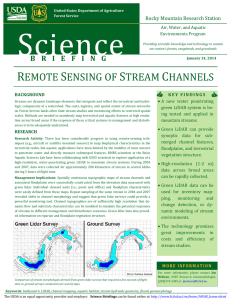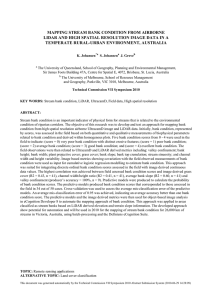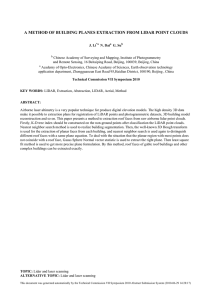Eos , Vol. 90, No. 39, 29 September 2009
advertisement

Eos, Vol. 90, No. 39, 29 September 2009 Other GOSIC Interactions In 2008, GOSIC began working with the Group on Earth Observations (GEO) portal (http://www.geoportal.org) to aid in providing comprehensive and coordinated Earth observations from thousands of services, instruments, collections, libraries, and catalogues worldwide to transform the collected data into vital information for societal use. The GOSIC data registry now is available on the GEO portal (http:// geossregistries.info/geosspub/component _ details _ns .jsp?compId =urn:uuid:24b7f5e8 -ccd1-4b9d -82ad -e9fa8a0811be) to aid in accessing data related to eight of GEO’s nine societal benefit areas: agriculture, biodiversity, climate, disasters, ecosystems, health, water, and weather (the ninth GEO societal benefit area, energy, was not included, as GOSIC has neither any thematic expertise in that area nor any energyrelated data set information at this time). GOSIC’s success depends on, and has benefitted from, user feedback to ensure that it remains a relevant, effective, and Improving Stream Studies With a Small-Footprint Green Lidar PAGES 341–342 Technology is changing how scientists and natural resource managers describe and study streams and rivers. A new generation of airborne aquatic-terrestrial lidars is being developed that can penetrate water and map the submerged topography inside a stream as well as the adjacent subaerial terrain and vegetation in one integrated mission. A leading example of these new cross- environment instruments is the Experimental Advanced Airborne Research Lidar (EAARL), a NASAbuilt sensor now operated by the U.S. Geological Survey (USGS) [Wright and Brock, 2002]. Standard airborne terrestrial lidars, which currently produce the highest-resolution maps of extensive land areas, use reflected near-infrared laser pulses to make millions of point measurements of ground and vegetation elevations. However, near-infrared energy is absorbed by water, which limits the use of these systems to mapping features outside of water bodies. EAARL uses a narrowbeam green, rather than near-infrared, laser with a footprint of only 15 centimeters from the nominal flying height (for system technical specifications, see Table S1 in the electronic supplement to this Eos issue (http:// www.agu.org/eos _elec/)). Streams and rivers are arguably the most dynamic components of natural landscapes. The physical characteristics of channels vary over a wide range of spatiotemporal scales as they respond to both natural and anthropogenic forcing. Biological complexity is layered on these physical dynamics, and biophysical linkages are formed inside streams and also across the aquatic-terrestrial boundary. These traits make it challenging to understand and manage stream systems. A primary difficulty has been a limited ability to describe the basic stream topography at spatial scales appropriate to the relevant physical and biological processes. Detailed field-based bathymetric surveys, often done by wading, normally are limited by costs and logistics to stream lengths of less than about 1 kilometer. Consequently, it has been hard to analyze biophysical processes and aquatic habitat over larger portions of channel networks. Access for field surveys also is often limited by ownership and water conditions, concerns that are largely avoided by remote aerial methods. Other remote sensing techniques have been applied over longer stream segments, but these may require some local calibration [Feurer et al., 2008; Gao, 2009]. EAARL offers an unusual combination of attributes: aquatic and terrestrial mapping at up to watershed scales (hundreds of kilometers of channel length), done with relatively high precision, accuracy, and spatial resolution [Kinzel et al., 2007; McKean et al., 2008]. EAARL Performance and Applications One test of the performance of EAARL is how well it maps in- channel topographic forms relative to traditional wading surveys. For example, does the EAARL accurately efficient tool for data access. The staff is open to incorporating new features, improving existing ones, and collaborating with other global environmental data access activities. To use the GOSIC tools, learn more information, and provide feedback to improve the portal, please visit http://GOSIC .org. —HOWARD J. DIAMOND, National Climatic Data Center (NCDC), National Oceanic and Atmospheric Administration, Silver Spring, Md.; E-mail: Howard .Diamond@noaa.gov; and CHRISTINA J. LIEF, NCDC, Asheville, N. C. define the locations and three- dimensional (3-D) geometry of major features such as pools and riffles? Figure 1 is a side- byside comparison of EAARL and field-surveyed channel bathymetry of a 150- meter length of a small channel. The maps of basic channel topography are very similar, and detailed field checking indicates that EAARL more accurately mapped the bed of the stream, as the higher- density lidar data detected two small deep pockets in the pool at 68º90’E, 32º65’N that the wading survey missed. The greatest lidar mapping errors appear to be in areas with sharp topographic curvature and steep slopes, such as along the steep stream banks in Figure 1. These errors can be reduced by decreasing the spacing between point measurements through adjustment of flight parameters such as aircraft height above ground level, increasing the laser pulse rate, or flying repetitive passes over a study area. More quantitative comparisons indicate that, in general, lidar measurements of local channel geometry using metrics such as width, maximum depth, and slope of the channel bed are within about 5% of those made by field surveys. Fig.1. Comparison of Experimental Advanced Airborne Research Lidar (EAARL) and fieldsurveyed channel bathymetry of a short reach of Bear Valley Creek in central Idaho. Dots in both plots indicate individual ground elevation measurements. The measurements in the field were made using the Global Positioning System with centimeter-scale horizontal accuracy. The density of lidar data was relatively low at this site, and the average lidar point spacing was 2.3 meters and 2.1 meters inside and outside the channel, respectively. A more typical point spacing inside and outside the channel in this study area is 1.8 meters. Topographic contours were produced by identical kriging from the respective point measurements. The top of the stream bank is at an elevation of approximately 1967.9 meters. The poorest match of lidar and field data is along steep banks where the lidar-generated topography is more rounded and less steep. Eos, Vol. 90, No. 39, 29 September 2009 While EAARL demonstrates the potential of narrow-beam, high-resolution bathymetric lidars, it is a research instrument with limited project capacity. The EAARL system currently is being modified to provide better water penetration and approximately 6 times greater and more uniform data density than the present instrument. Research also is under way to explore the range of channel conditions that might limit the use of EAARL surveys. For example, entrained air bubbles in turbulent flows and sediment suspended in the water cause point reflections of laser energy in the water column and reduce laser penetration to the channel bed. Some organic contaminants also absorb laser energy. At water depths less than about 10–20 centimeters, laser reflections from the water surface can become convolved with channel bed reflections. Applications of this new technology to streams include (1) constructing and analyzing maps of the topography and aquatic physical habitat at spatial scales from tens of meters to hundreds of kilometers, (2) monitoring changes in the physical structure of GEOPHYSICISTS Honors PAGE 342 Two AGU members are among the 24 new MacArthur Fellows, which the John D. and Catherine T. MacArthur Foundation channels, (3) defining channel boundary conditions necessary for biological models and 1-D and 2-D fluid dynamics models of water flow and sediment transport, (4) examining linkages between aquatic and terrestrial biophysical systems, and (5) designing and monitoring stream restorations. Examples of other EAARL system components and derivative products are included in the electronic supplement. Acknowledgments Development of the EAARL system and applications of the bathymetric data have been supported by NASA, USGS, the U.S. Forest Service, the U.S. National Oceanic and Atmospheric Administration, and the Bonneville Power Administration. We thank an anonymous reviewer for useful comments on this manuscript. References announced on 22 September. The foundation noted that Peter Huybers, assistant professor of Earth and planetary sciences at Harvard University, Cambridge, Mass., is a climate scientist “mining a wealth of oftenconflicting experimental observations to develop compelling theories that explain global climate change over time.” Daniel Sigman, Dusenbury Professor of Geological and Geophysical Sciences at Princeton University, Princeton, N. J., was cited as a biogeochemist “unraveling the interrelated physical, chemical, geological, and biological forces that have shaped the oceans’ fertility and the Earth’s climate over the past two million years.” Each fellow will receive US$500,000 in “no strings attached” support over the next 5 years. observations of the past and model predictions of the future. The Urgent Need for Improved Climate Models and Predictions An investment over the next 10 years of the order of US$2 billion for developing improved climate models was recommended in a report (http://wcrp.wmo.int/ documents/ WCRP_WorldModellingSummit _ Jan2009.pdf) from the May 2008 World Modelling Summit for Climate Prediction, held in Reading, United Kingdom, and presented by the World Climate Research Programme. The report indicated that “climate models will, as in the past, play an important, and perhaps central, role in guiding the trillion dollar decisions that the peoples, governments and industries of the world will be making to cope with the consequences of changing climate.” If trillions of dollars are going to be invested in making decisions related to climate impacts, an investment of $2 billion, which is less than 0.1% of that amount, to —JIM MCKEAN and DAN ISAAK, Rocky Mountain Research Station, U.S. Forest Service, Boise, Idaho; E-mail: jmckean@fs.fed.us; and WAYNE WRIGHT, Florida Integrated Science Center, U.S. Geological Survey, St. Petersburg Feurer, D., J.- S. Bailly, C. Puech, Y. L. Coarer, and A. A. Viau (2008), Very- high-resolution mapping FORUM PAGE 343 of river-immersed topography by remote sensing, Prog. Phys. Geogr., 32(4), 403–419. Gao, J. (2009), Bathymetric mapping by means of remote sensing: Methods, accuracy and limitations, Prog. Phys. Geogr., 33(1), 103–116. Kinzel, P. J., C. W. Wright, J. M. Nelson, and A. R. Burman (2007), Evaluation of an experimental LiDAR for surveying a shallow, braided, sandbedded river, J. Hydraul. Eng., 133, 838–842. McKean, J. A., D. J. Isaak, and C. W. Wright (2008), Geomorphic controls on salmon nesting patterns described by a new, narrow-beam terrestrialaquatic lidar, Frontiers Ecol. Environ., 6(3), 125–130. Wright, W., and J. Brock, (2002), A lidar for mapping shallow coral reefs and other coastal environments, paper presented at the 7th International Conference on Remote Sensing of Marine and Coastal Environments, Miami, Fla., 20–22 May. provide better climate information seems prudent. One example of investment in adaptation is the World Bank’s Climate Investment Fund, which has drawn contributions of more than $6 billion for work on clean technologies and adaptation efforts in nine pilot countries and two pilot regions. This is just the beginning of expenditures on adaptation efforts by the World Bank and other mechanisms, focusing on only a small fraction of the nations of the world and primarily aimed at anticipated anthropogenic climate change. Moreover, decisions are being made now, all around the world— by individuals, companies, and governments—that affect people and their livelihoods today, not just 50 or more years in the future. Climate risk management, whether related to projects of the scope of the World Bank’s or to the planning and decisions of municipalities, will be best guided by meaningful climate information derived from Climate Risk Management Across Time Scales Adaptation to climate change is a problem of the present, and adaptation efforts encompass more than human- driven changes in the mean climate at the end of the 21st century. Much of the world, and especially developing countries, now faces vulnerabilities and opportunities related to weather and climate. Many decision makers are aware of and use the predictions of changes in mean climate at the end of the 21st century, such as those made by the Intergovernmental Panel on Climate Change’s (IPCC) Working Group I in the Fourth Assessment Report [Meehl et al., 2007; Christensen et al., 2007]. Fewer people are aware that climate predictions, using the same types of models used in the IPCC process, produce climate forecasts for the coming seasons, years, and soon, decades into the future [Taylor et al., 2008]. Thus, it is imperative to produce models that faithfully capture the physical processes of the climate system so that climate changes—a year, decade, or century into the future—can be anticipated and described with appropriate estimates of uncertainty.






